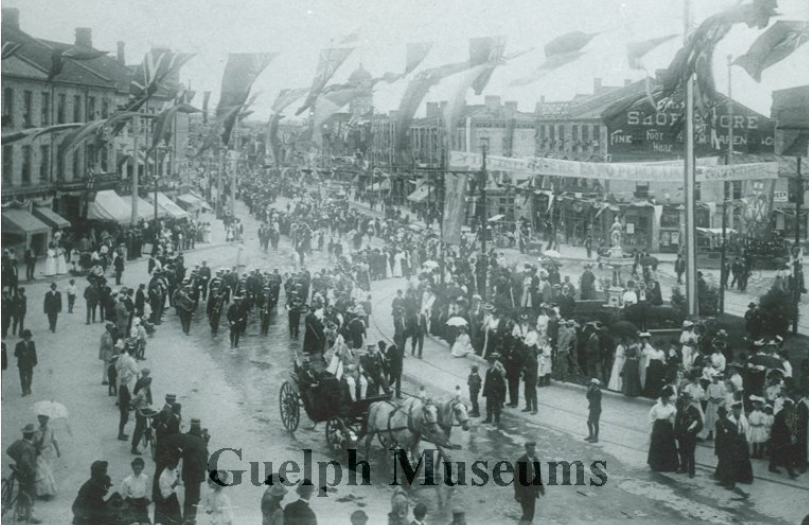On the evening of July 24, 1908, an estimated 5,000 people packed Wyndham Street. From one end of the thoroughfare to the other, the crowd occupied not only the sidewalks, but the road itself. And why not? It was newly paved! No more of the dust that had been the curse of hot, dry summers, or the mud that had made Guelph’s downtown a pedestrian nightmare and the bane of one’s Sunday shoes.
But it wasn’t what was underfoot that had drawn so many residents to the town’s core. Rather, they had come in eager anticipation to witness what was going to happen overhead. For the first time, downtown Guelph was going to be illuminated by electric lighting. The Mercury reported on the historic moment when the lights went on.
“When the many electric lights, which form a radiant canopy over the whole of Wyndham Street, were turned on, the whole expanse, covered with a permanent roadway as white and clean as the sidewalks, became as light almost as during the day. The effect was beautiful to behold and everywhere were to be heard expressions of admiration.”
The lighting was considered a great sensation. It was hoped to be a forecast of the success of an event that had been planned for months; Guelph’s Old Home Week that was coming up in August.
Guelph had extended an invitation to former residents to come home for a summer bash that promoters promised would be “the greatest and best organized Old Home Week ever held in Canada.” They said they had learned from mistakes made by other communities and expected everything to come off without a hitch. “There can be no doubt of the extent of the success of the event,” the Mercury boasted.
Trains rolled into the station bringing ex-Guelphites from across Canada as well as the United States. There were even a few from overseas. News of the event had been carried in the press in cities as far away as Buffalo, New York. The local hotels were booked up, and residents opened their homes to relatives and friends they hadn’t seen in years.
Downtown streets were decorated with flags and bunting, all of which would look extra special at night in the glow of the new electric lights. The grounds of Exhibition Park had been prepared for a variety of attractions that included concerts and athletic competitions.
Guelph’s own renowned composer, Roberta Geddes-Harvey, wrote a song for Old Home Week. The first verse went:
The boys are coming home today!
Home today! Home today!
The boys who have been far away!
Far away! Far away!
Some from distant foreign lands,
Some from Yukon’s golden sands;
Here we are to meet and greet
The boys who have been far away.
“The boys” were a diverse group. One was John Moffat, who came from his home in Berlin (now Kitchener) hoping to interest the Guelph Waterworks Department in a fuel-saving device he’d invented. He couldn’t sell them on his invention, but he told Mayor John Newstead and the Mercury stories about his grandfather who had helped cut the first road from Guelph to Galt with a crew of men who lived on a diet of raw pork and whiskey.
Another was John C. Kennedy of Port Elgin. Born on Nov. 7, 1830, he claimed to have been the second male child born in Guelph. According to the Mercury, Kennedy was the oldest Guelph boy to come to town for Old Home Week.
Probably the most prestigious Guelph-born visitor was Sir Charles Edmund Kingsmill. He was an admiral in the Royal Navy and would one day be credited as a father of the Royal Canadian Navy. A series of formal dinners and receptions were planned for Kingsmill, and he would preside over a military tattoo in Exhibition Park.
Among the sporting events scheduled were baseball games, horse and pony races, and a “Dare-devil-dash” bicycle race that started on a slide from an elevation of 100 feet and concluded with a leap into a tank of water. Foot races were divided up into special categories for boys and girls, single men and ladies, married men and ladies, old men (over 50 years), and men over 200 pounds. One foot race was open only to boys who belonged to Guelph Collegiate Institute Cadets.
Guelphites would also have an opportunity to see wrestling star Artie Edmunds of Toronto, who fought under the name Edmunds the Great. Hailed as “the most wonderful wrestler of his weight in America,” Edmunds was coming to town for Old Home Week to take on Young Gussie of Chicago.
The Mercury announced that “All kinds of attractions and amusements will be furnished by the Committee for young and old, consisting of merry-go-round, chute-the-chute, electric theatre, waxworks, Ferris wheel, moving picture shows, and anything else of the kind that can be procured.” The very daring could go up in a hot air balloon for a bird’s-eye view of the city.
Of course, then, as now, care had to be taken that all was proper and in good taste. The newspaper went on to say, “The Committee wish to assure the public that there will be nothing there that could offend the most fastidious.” Nonetheless, a few people were concerned that the glare of those new lights might frighten the horses.

.png;w=120;h=80;mode=crop)

